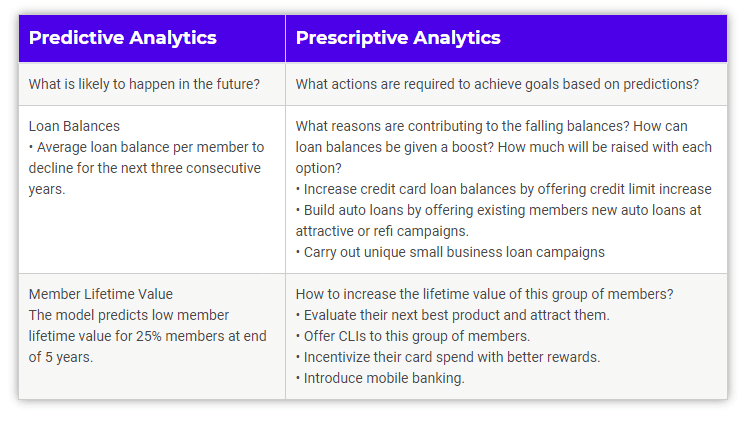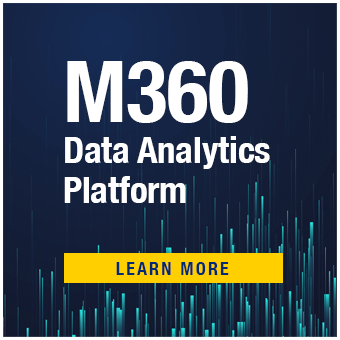It was not long ago credit unions were new to the world of data analytics. Fast forward to today, and credit unions have understood the value of their member data – be it demographic, behavioral or transactional. More and more credit unions are making arrangements to capture this rich data, and many others have already mastered the science of data analytics and putting their data to test. The revelations made by the data are eye-opening for credit unions. They are learning new things about their membership.
With this wide acceptance of data analytics being in the credit union industry, what will distinguish the best performing credit unions from the others and let them get ahead of the competition? The answer would be their ability to race through the analytics maturity curve by adopting more sophisticated and advanced data science tools like predictive and prescriptive analytics. This technology can help credit unions uncover what the future may hold for them accurately and confidently.
Delving Into Past and Present Data is a Necessity
Let’s look closely at the type of data analytics currently used by most credit unions. We will find that they are concentrated in the domain of descriptive and diagnostic analytics, analyzing the past and tracking the present. This means they are successfully deciphering what happened and why it happened. In line with this growing curiosity of credit unions, using business intelligence and visualization tools to keep track of portfolio and member level metrics is gaining popularity. This is viewed as a standard practice at many credit unions, helping its product managers and C-level executives make strategic decisions. Let’s look at some examples closely:

The descriptive and diagnostic analytics does give a peek into the problems and causes for it. This information is undoubtedly beneficial and vital, but this explains what has happened and why it is happening. They are the keys to the past and present, but what about the future?
It’s the need of the hour to take this analysis to the next level. Knowing the future is always inspiring and possessing the ability to alter it is even more exciting. This is what predictive and prescriptive analytics can do.
Using Predictive Analytics to Know the Future
Predictive analytics can tell what will happen in the future. It uses historical data to build models that predict future outcomes. It helps capture complex trends, patterns and relationships which might be overlooked by a human mind otherwise and use them to extrapolate the future outcomes. These models are memory-heavy and demand additional technologies like R/Python, Google TensorFlow and Microsoft cognitive toolkit.
The precision and quality of predictions depend upon the quantity and accuracy of past data used in the process. The predictive analytics models, often using AI or machine learning, act as a black box. It helps us investigate the future but does not divulge insights into the reasons for a predicted outcome. For example, predictive analytics would tell the credit union that its long-time member, Mr. A, has an extremely high chance of attrition in the next six months. But it would not hint at the reasons behind it or suggest any preventive actions to stop Mr. A from leaving. There lies a gap between getting the predictive model output and ‘using’ it for the better. Prescriptive analytics plugs this gap efficiently.
Resort to Prescriptive Analytics to Create Your Desired Future
Prescriptive analytics is deeper than predictive analytics in analyzing the underlying reasons for the potential outcome and evaluating multiple ways to alter it. To stay afloat in this competitive financial industry, opting for only predictive analytics is not sufficient.
Prescriptive analytics must drive actions and strategies to make the predicted outcomes more desirable and favorable or even accelerate the positive results. Building on the attrition example above, prescriptive analytics can help the credit union evaluate ways to stop Mr. A from leaving. It can help calculate the likelihood for Mr. A to stay when offered better checking rates, waive the checking account fees, extended better card usage rewards, etc. The effect of the combination of the above can also be calculated to see Mr. A’s willingness to stay.
Prescriptive analytics is where all the action happens. It tells how to act on the predicted events. Let’s discuss a few more applications of predictive and prescriptive to understand the difference.

Key to Powerful Business Insights
It is essential to understand that predictive and prescriptive analytics go in conjunction with descriptive and diagnostic analytics. They are not either/or options. They are like a continuum where the farther you move from descriptive towards prescriptive analytics, the chances you can better leverage your data and make strategic decisions with more precision and confidence increases. A well-planned data-driven analysis is the key to powerful business insights that can give a big push to a credit union’s growth and profits.










